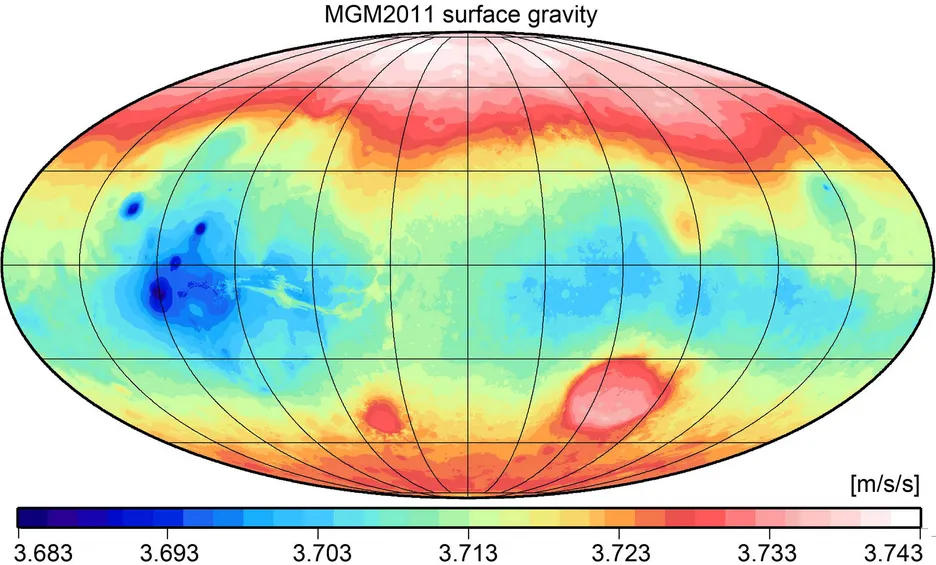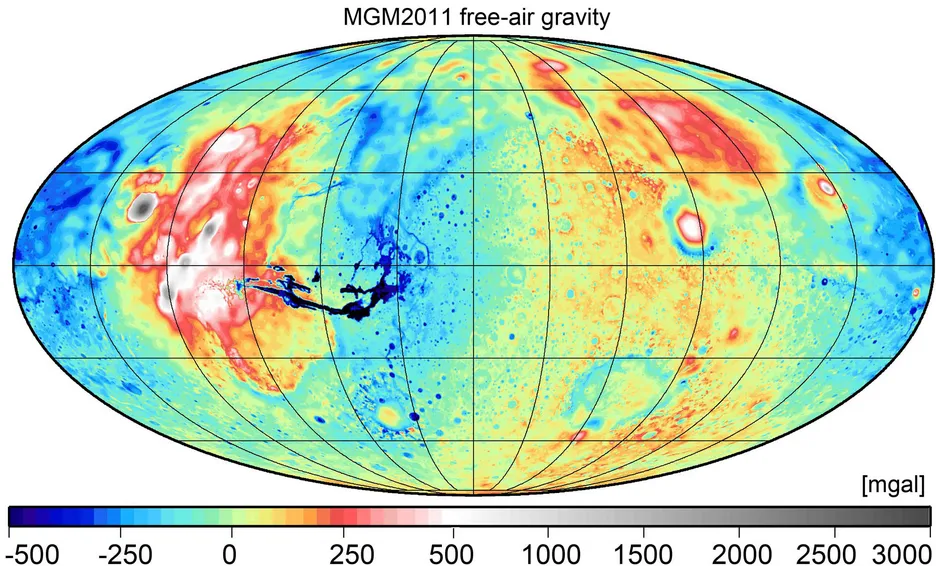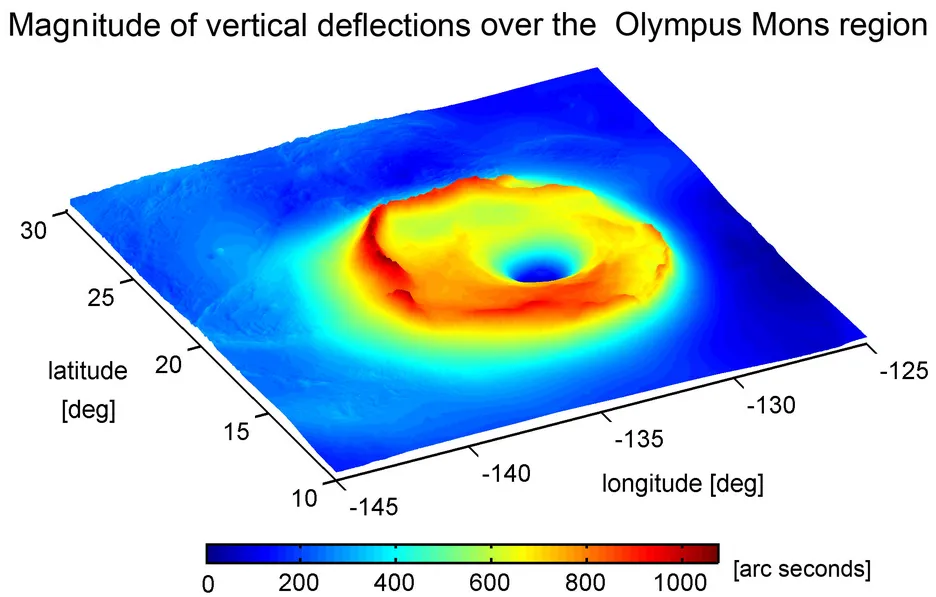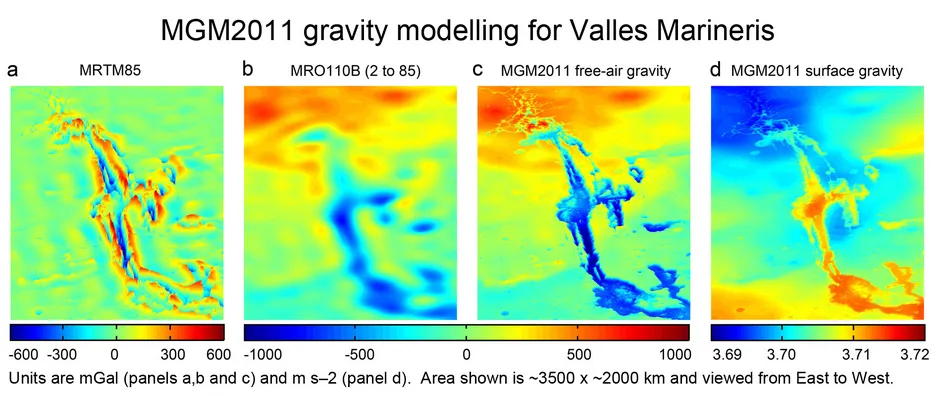Mars Gravity Model 2011 (MGM2011)
General
MGM2011 (Hirt et al. 2012) is a gravity field model for Mars that resolves features down to km-scales. The development of MGM2011 was coordinated by Dr Christian Hirt (now TUM-IAPG) while at Curtin University (Perth, Western Australia). The model, software and documentation can be accessed via the repository at http://ddfe.curtin.edu.au/models/MGM2011/ (or the mirror site at: https://ddfe.blazejbucha.com/models/MGM2011/)
The MGM2011 model is constructed as a composite of a normal gravity field, a recent space-collected gravity field and Newtonian gravity forward-modelling.
- The normal gravity field approximates Mars's gravitational attraction as rotating mass-ellipsoid,
- space-collected gravity (MRO110B2, Konopliv et al. 2011) delivers anomalies of the Martian gravity field down to scales of ~125 km, and
- Newtonian forward-modelling and high-resolution Mars topography data from laser altimetry (MOLA, Smith et al. 2001) is used to derive topography-implied gravity (MRTM85) at spatial scales of ~125 km down to ~3km.
The innovation of MGM2011 lies in the use of topography-implied gravity (MRTM85) to augment Mars space-collected gravity at medium and short-scales. MGM2011 surface gravity accelerations (Fig. 1) and free-air anomalies (Fig. 2), and vertical deflections (Fig. 3) are provided at 0.05° resolution (3600 x 7200 = 25.92 million points) over the entire surface of Mars.
High-resolution views on Mars gravity
MGM2011 is the first model to resolve the (expected) Martian gravity field down to km-scales. MGM2011 surface gravity accelerations are maximum with 3.7426 m/s2 at the bottom of the Jojutla crater (81.6°N, 169.3°W) in the low-lying Northern plains. The minimum of 3.6838m/s2 is at the rim of Arsia Mons (8.4°S, 121.4°W), the southernmost of the Tharsis shield volcanos (Fig. 1). The average MGM2011 surface gravity acceleration is 3.7208 m/s2 with a global range of ~0.059m/s2 or 1.6 %.
MGM2011 vertical deflections, the angle between the ellipsoid normal and the plumb line, exhibit notable variability (Fig.3.), specifically over the Tharsis region. Maximum values are encountered near (18°N, 136°W), West of Olympus Mons. The gravitational pull of Mars's famous ~22 km high shield volcano deflects the plumb line by more than 1000 seconds of arc (~ 0.28°) from the ellipsoidal normal (Fig. 4).
Fig. 5 shows detail perspective views of the MGM2011 gravity modelling for Valles Marineris, Mars's largest Canyon system of ~3500 km length. In this most rugged area, MRTM85 gravity (Fig. 5a) adds much detail that is not resolved by the space-collected MRO110B2 (Fig. 5b). Views of MGM2011 free-air gravity, computed as MRTM85 plus MRO110B gravity (Fig. 5c), and MGM2011 surface gravity accelerations (Fig. 5d) provide a good impression of the ruggedness of Mars's gravity field down to km-scales.
MGM2011 gravity over Gale crater (Curiosity landing site)
Fig. 6 shows the topography (panel A) and gravity field (panels B, C) over the Gale crater, where NASA’s Mars rover Curiosity en.wikipedia.org/wiki/Curiosity_rover was successfully landed on 6th August 2012.
The MGM2011 gravity acceleration at the landing site (-4.5919S 137.4403E) is about 3.7133 ms-2, also see Fig. 6B for the variation of surface gravity accelerations over Curiosity’s investigation area. From Fig. 6C, the direction of gravity (with respect to the Mars ellipsoid) changes up to 250 seconds of arc within 30 km radius around the landing site.
References
Hirt C, Claessens SJ, Kuhn M, Featherstone WE (2012) Kilometer-resolution gravity field of Mars: MGM2011.Planetary and Space Science, 67(1):147–154 DOI: 10.1016/j.pss.2012.02.006.
Konopliv A.S. et al. (2011), Mars high resolution gravity fields from MRO, Mars seasonal gravity, and other dynamical parameters, Icarus, 211, 401-428.
Acknowledgements
This work has been supported by the Australian Research Council (Grant DP120102441).
Contact
Dr. Christian Hirt





